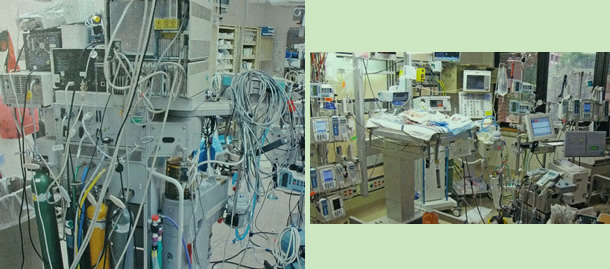I am an anesthesiologist in a children’s hospital affiliated with a large university medical school. I work in both the operating room (OR) and the intensive care unit (ICU) where I care for children who are recovering from surgery for congenital heart disease. My colleagues and I often discuss the design of clinical information systems. The underlying theme of our conversations is that information transfer is a key element of patient care. In my opinion, the contrast between my work environment in the OR and ICU illustrates how the quality of information transfer can impact patient care.

I enjoy the working in the OR. I generally provide anesthetic care to one, at most, two patients at a time. There are few distractions in a highly focused environment, and it is reassuring to see the familiar faces of my trusted colleagues. Although we run a busy OR, we have a relatively compact staff. While we haven’t seen it all before, we have seen almost everything. We are continuously involved from the start to the end of each case. The anesthesia workstation is a complex system (See Figure 1), but although the volume of data generated during an operation is large, it is on a manageable scale. If, for example, somebody needs to know how much fluid was given at a certain time, I can either remember, because I gave it myself, or I can check the anesthesia record kept by my resident and myself. The members of the OR team are in constant communication, so it is unusual for information transfer failure to occur within the operating room.
Although I also enjoy working in the ICU, the environment offers a different challenge. In contrast to the OR, the average daily ICU census is eight to twelve patients. Many have multi-system organ dysfunction and may have multiple urgent issues that require attention simultaneously. There are many distractions, and information overload is the norm. To the inexperienced, the complexity can be bewildering (See Figure 2). We hand over patient care at shift change twice a day, so information is often transmitted via intermediaries. Just as in audio transmission, signal degradation occurs at all points, and the quality of clinical information is rarely improved at handover. With a larger nursing staff, the corporate memory is diluted when compared to the OR.
The ICU is a “perfect storm” environment where the volume of data is immense, the time available to process it is limited, and the consequences of misinformation are most likely to lead to adverse outcomes because our patients have limited physiologic reserves. Sometimes it seems that the ICU team spends the entire working day foraging for data. A complete patient evaluation pulls data from disparate sources, including the physical examination, history, laboratory and imaging studies, pharmacy orders, physiologic monitoring, nursing observations, and consultations from other specialists. The good news is that information systems can integrate and display most of these data. The not-so-good news is that display is typically organized by the source, forcing us to scroll through multiple pages for inter-related data.
When I log on, the system should know who I am, what I do, my area of expertise, and who the patient is. It should quickly show me screens directly related to my area of expertise, and the most likely data of interest from that patient, in a contextual visualization as envisioned by information design guru Edward Tufte. For example, when evaluating the progress in weaning a patient off a ventilator, I need relevant lab studies, chest x-ray, ventilator settings, and other important data. The challenge to the information design and usability community is to find ways to display this type of functional data in a useful manner. The information system needs to be intuitive, simple, and easy to navigate. The nurses should feel that the system is designed to help them provide better care rather than distract them from their essential task. The visual display should be attractive and important data relationships obvious. The temporal resolution should be high enough that we can review stored clinical data when troubleshooting critical events.
There are many challenges to all of us who work in ICUs today. We have more older—and sicker—patients. We are performing procedures of increasing complexity on patients who, in the past, would have been denied operations because they were too ill. We have scarce staffing resources and increasing production pressure as a result of declining reimbursement. By 2020 it is estimated that 50 percent of hospital inpatients will be in ICUs. High quality data acquisition and processing will be absolutely essential. The information design and usability community have a superb opportunity to partner with clinicians to design the tools that will help us overcome these challenges.
